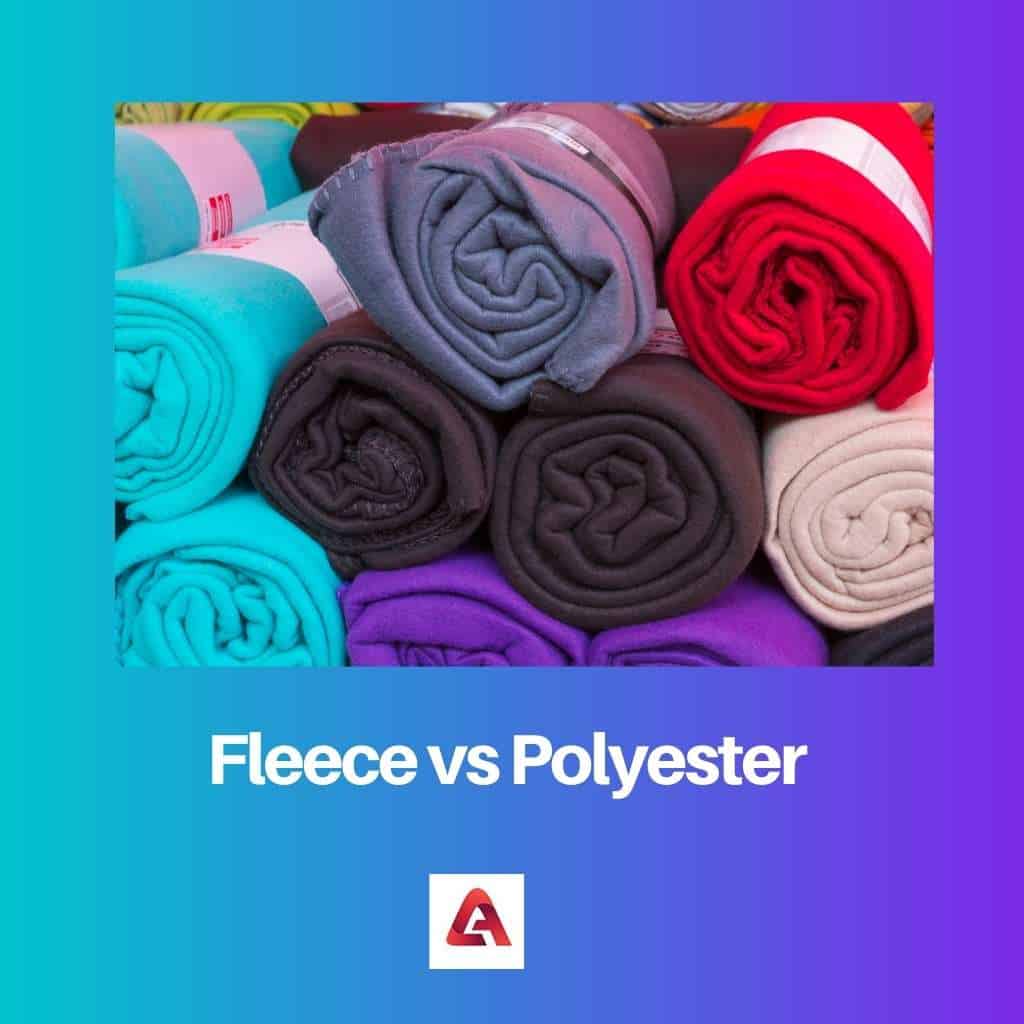Fleece and Polyester are two of the excellent fabrics in the market. The fabrics may seem similar as they are man-made fabrics.
But, there are some key features and characteristics that distinguish fleece from polyester. This will help you to decide which fabric is the best for you.
Key Takeaways
- Fleece provides more insulation and warmth than polyester, making it ideal for colder climates.
- Polyester dries faster and wicks moisture away from the body, making it suitable for activewear.
- Fleece is derived from natural sources, while polyester is a synthetic material from petroleum products.
Fleece vs Polyester
Fleece is a warm, knit fabric made thick by wrapping threads around each other that is made from polyester. Polyester is synthetic fabric in the category of polymers that’s derived from petroleum. It is an incredibly strong fabric that doesn’t tear, stretch, or pill easily.

Fleece is a synthetic, insulating fiber, developed from a particular type of polyester known by the name of Polyethylene Terephthalate (PET). It is known for its ability to block humidity from the outside.
It is a piece of comfortable fabric. The major advantages of the fabric are its anti-perspiration qualities and its lightweight.
Polyester is a fabric derived from petroleum and other compounds in the ether functional group. It is one of the highest-selling fabrics in the world and is used in various types of industries due to its durability, versatility, and wide range of applications in several industries.
Comparison Table
| Parameters of Comparison | Fleece | Polyester |
|---|---|---|
| Definition | A man-made fiber to be used as a mid-layer for outdoor activities. | Fabric whose polymers are created from organic sources or fossil fuels such as petroleum. |
| How is it made? | Created with a combination of synthetic and natural fibers. | Polyester is developed with a blend of petroleum, natural fibers such as cotton and wool. |
| Breathability | Fleece allows air to pass through it. It is highly breathable. | The breathability of polyester depends on the ratio of polyester with other fabrics. |
| Durability | It is durable though cotton fleece is less durable and shreds microfiber over the washing cycles. | Polyester is highly durable and does not tear, pill, or shred easily. |
| Where is it used? | It is highly used for sportswear and winter jackets. | Used in a variety of textiles, home decor, and articles of clothing. |
What is Fleece?
Fleece, a durable fabric created with the help of Polyethylene Terephthalate (PET). It is lightweight and comfortable to wear.
It is one of the best fabrics for sportswear and winters. Fleece can be made with 100% polyester but is developed with the help of other synthetic fibers, and natural fibers such as cotton, wool.
It can also be derived from recycled fabrics such as recycled PET plastic.
Polartec, an American textile maker in the 1970s developed fleece fiber as an exploration and experimentation with polyester fiber. It was introduced in the sportswear market and has developed into a trendy fiber. With the technology of fleece increasing manifolds, the yarn of fleece is now minutely fine and intricate.
The technology of fleece is developed to develop high-quality fleece garments from recycled plastics as well. It is a cozy and less-scratchy fabric as compared to other fabrics such as nylon and woolen.
Fleece is an ideal fabric for changing climates. It is a preferable fabric among other winter fabrics as it is easy to clean and dries up quickly.
Fleece jackets, sweatshirts, and sweaters do not require dry-cleaning, dusting, and softening every winter season.

What is Polyester?
Polyester, also known by the name of PET. It is efficient to wash. The ideal washing temperatures involve warm, hot, and cold temperatures.
Thus, making it a versatile and durable fabric. Polyester is a popular fabric for clothing articles such as hoodies, pants, jackets, socks, sheets, blankets, rope, underwear, hats, and upholstery as well.
Polyester is commonly used in combination with other natural fabrics such as cotton, wool, jute, and more. Blended polyester with cotton improves the wrinkling, durability, and shrinkage abilities of the fabric.
Polyester is a perfect fabric for outdoor activities for a long-term period.
It is a multi-use fabric and has always been used as a cheaper alternative to cotton. It is a perfect fabric for formal, business, and casual occasions.
There are different types of polyester fabrics such as Ethylene polyester, Plant-based polyester, and PCDT Polyester. Though it is one of the cheapest fabrics available in the market, plant-based polyester costs more than the other types of polyesters.
It is less durable than PET.
Polyester has a huge history dating back to the year 1941. It was created by John Rex, a British chemist.
It is easy to dye and an ideal choice for outdoor clothing.

Main Differences Between Fleece and Polyester
- Fleece is more sustainable than Polyester as fleece is developed with recyclable fabrics and other substances including plastic goods like bottles.
- The fleece consists of microfibers which may be shed over time. Polyester is a combination of large fibers of the yarn. Polyester consists of 200-1000 fibers in a clothing article.
- Fleece is not an ideal fabric for summers and is highly involved in winter clothes such as winter jackets, blankets, and sweaters. Polyester is a versatile fabric and can be used in the summer and winter seasons depending on the fabrics blended with polyester.
- High-quality fleece clothes such as Cotton fleece are more expensive than other fleece items. Polyester is one of the most affordable fabrics in the market.
- Fleece is not biodegradable but it is a superior fabric to Polyester as it is derived from recyclable sources.




